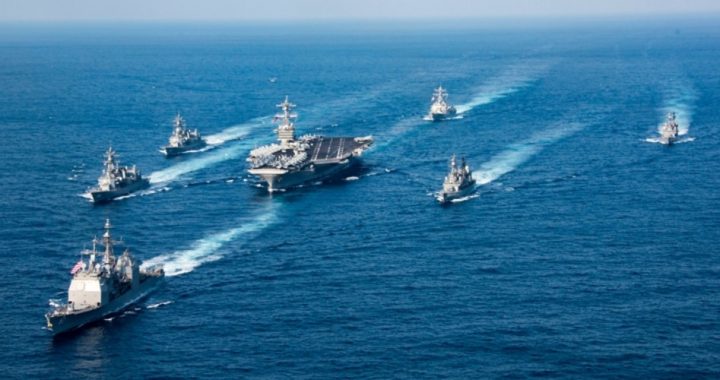
U.S. Navy ships are conducting simultaneous naval exercises with ships from the Republic of Korea Navy and with the Japan Maritime Self Defense Force on April 25 and 26, stated a press release posted by the U.S. 7th Fleet’s Public Affairs office on April 25.
The destroyers USS Wayne E. Meyer and ROKN Wang Geon are conducting combined maritime exercises in waters west of the Korean Peninsula, while the destroyers USS Fitzgerald and JMSDF JS Chokai will execute combined maritime exercises in waters west of Japan, stated the press release.
The release stated that the purpose of both exercises is to “demonstrate a shared commitment to security and stability in Northeast Asia as well as the U.S. Navy’s inherent flexibility to combine with allied naval forces in response to a broad range of situations.”
Though the release did not elaborate on what “a broad range of situations” might include, the growing tensions in the area of the Korean peninsula and the recent threats made by the government of North Korea undoubtedly were taken into consideration by our military.
North Korea’s state-run website, Uriminzokkiri, recently posted a statement from the Pyongyang regime threatening to “bury [the USS Carl Vinson] at sea,” saying the nuclear-powered aircraft carrier’s redirection demonstrates a looming invasion of the country.
“The world would clearly see how the US’ rash, arrogant aircraft carriers turn into a lump of scrap metal and gets buried at sea, and how the country vanishes from the Earth,” boasted the North Korean propaganda machine. “Our super-hard-line responses include sudden, pre-emptive strikes involving land, naval, underwater and airmobile assets,” the North Koreans continued.
A second press release posted by the 7th Fleet’s communications officer reported that the Ohio-class guided-missile submarine USS Michigan had arrived in Busan, South Korea, for a regularly scheduled port visit while conducting routine patrols throughout the Western Pacific.
“This visit is yet another example of the steadfast ROK and U.S. naval partnership,” the release quoted Rear Admiral Brad Cooper, commander of U.S. Naval Forces Korea. “We [U.S. and ROK navies] work closely with one another every day of the year and this well-deserved port visit is a chance for Michigan Sailors to enjoy the wonderful Busan culture that U.S. Navy Korea Sailors experience each and every day.”
While the official explanation is that the visit is routine and the statement emphasized the cultural benefits to the crew of making port in South Korea, the explanation of the ship’s weaponry that followed clearly indicated that our government intended the presence of the Michigan to send a message to the North Koreans that we mean business. It stated:
USS Michigan is one of four Ohio-class guided-missile submarines. The Navy’s guided-missile submarines provide the Navy with unprecedented strike and special operation mission capabilities from a stealthy, clandestine platform. Armed with tactical missiles and equipped with superior communications capabilities, guided-missile submarines are capable of launching missile strikes and supporting Special Operation Forces (SOF) missions.
The Michigan was one of four Ohio class submarines modified as cruise missile submarines (SSGN). Each SSGN has 22 missile tubes, with seven Tomahawk cruise missiles per tube, totaling 154.
The Tomahawk cruise missile was the weapon of choice during the recent U.S. attack against Shayrat air base in Syria. The United States fired 59 BGM-109 Tomahawk Land-Attack Cruise Missiles (TLAM) at Shayrat air base during that attack. Surely, the North Koreans are aware of that fact, as well as the fact that the Michigan carries 154 similar missiles.
If the Michigan’s port of call at Busan is officially considered to be routine, the diversion of the USS Carl Vinson aircraft carrier strike group for exercises off the Korean peninsula is anything but. President Trump described the strike group being sent to the seas off Korea as an “armada,” and the message intended for the North Korean regime is inescapable.
Photo of USS Carl Vinson, USS Wayne E. Meyer, and USS Lake Champlain with Japan Maritime Self-Defense Force destroyers: AP Images
Related articles:
As N. Korea Celebrates Anniversary of Military, S. Korea Is on Alert
North Korea Threatens to Attack U.S. Carrier Group; Detains U.S. Citizen
Russia Says Troop Movement Near North Korean Border Was Scheduled
North Korea Threatens U.S. With “All Out War” and “Weekly Missile Test”
North Korea Warns of Nuclear Retaliation at Any Sign of U.S. “Aggression”
North Korea Admits Missile Launches Were Test of Possible Strike Against U.S.Bases in Japan
North Korea Missile Test Draws Reactions From Trump, Abe, and UN
North Korea Claims to Test H-Bomb
North Korea Postures With Nuclear Warning, Movement of Missiles
North Korea Attacks South Korea
The Aftermath of the Sinking of the South Korean Ship Cheonan
North Korea Prepares to Launch Missile
North Korea Issues Threats During U.S.-S. Korean Joint Exercise
North Korea Sentences U.S. Student to 15 Years of Hard Labor
Lawmakers Blast UN for Handing U.S. Technology to North Korea, Iran



